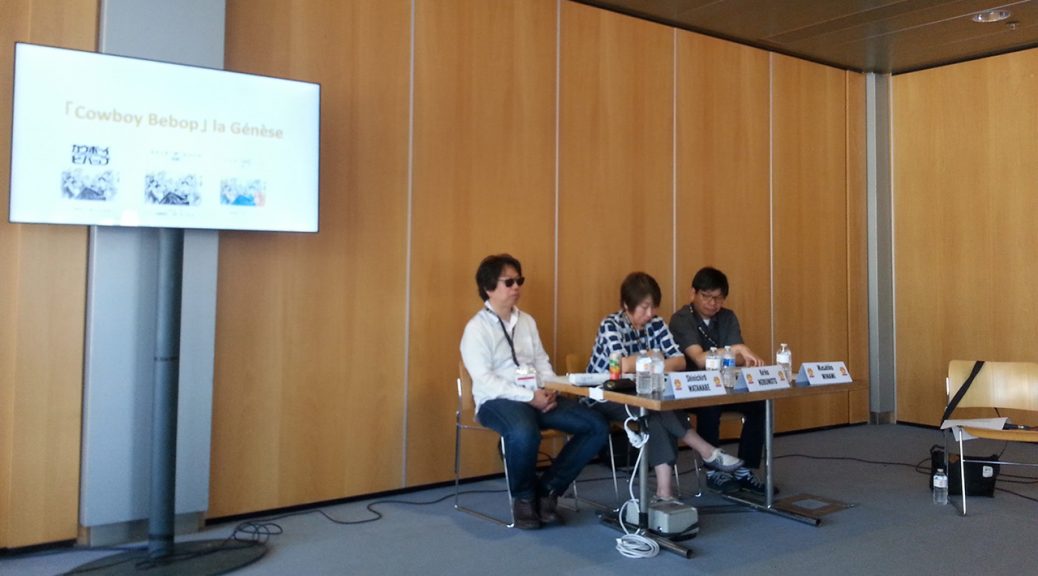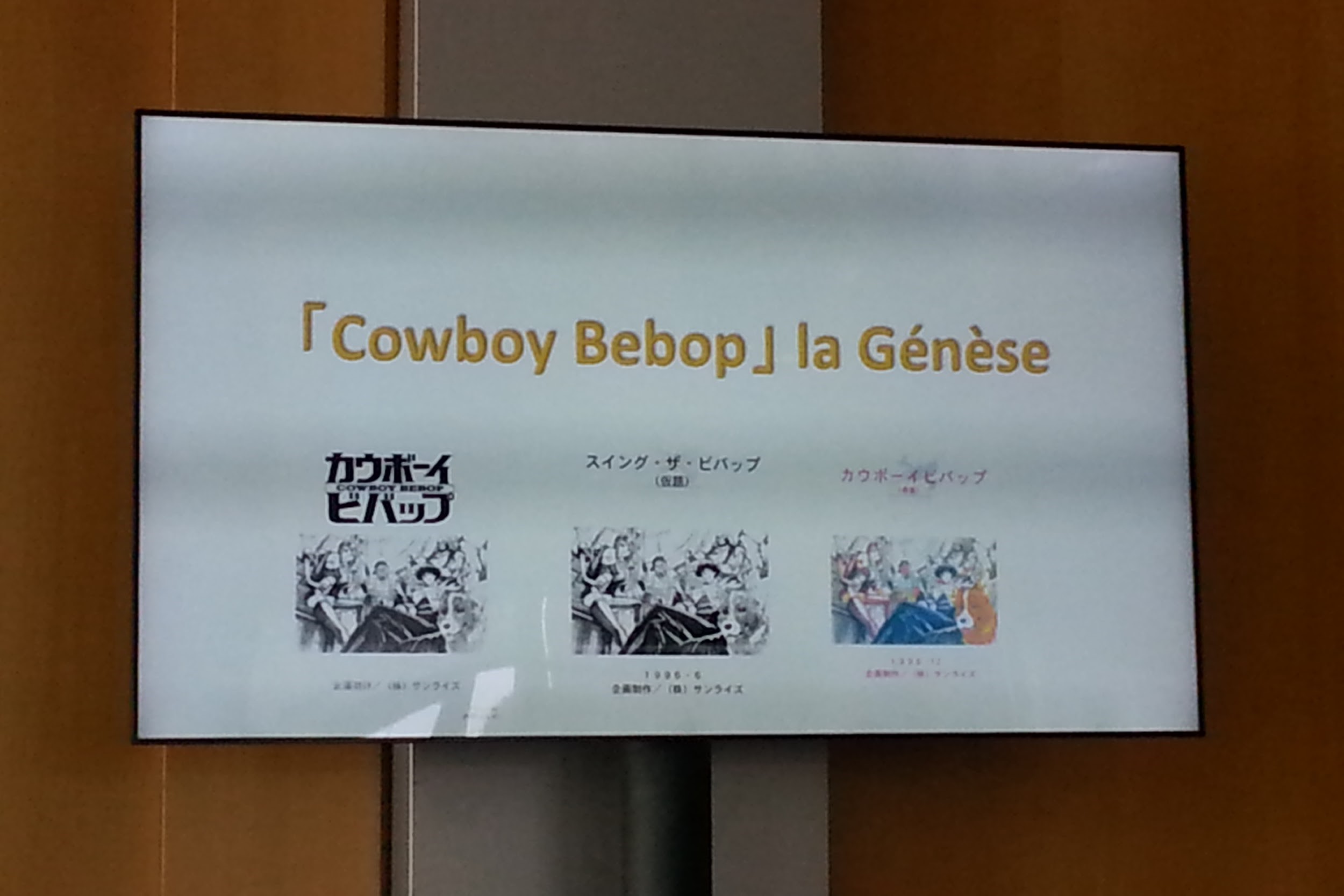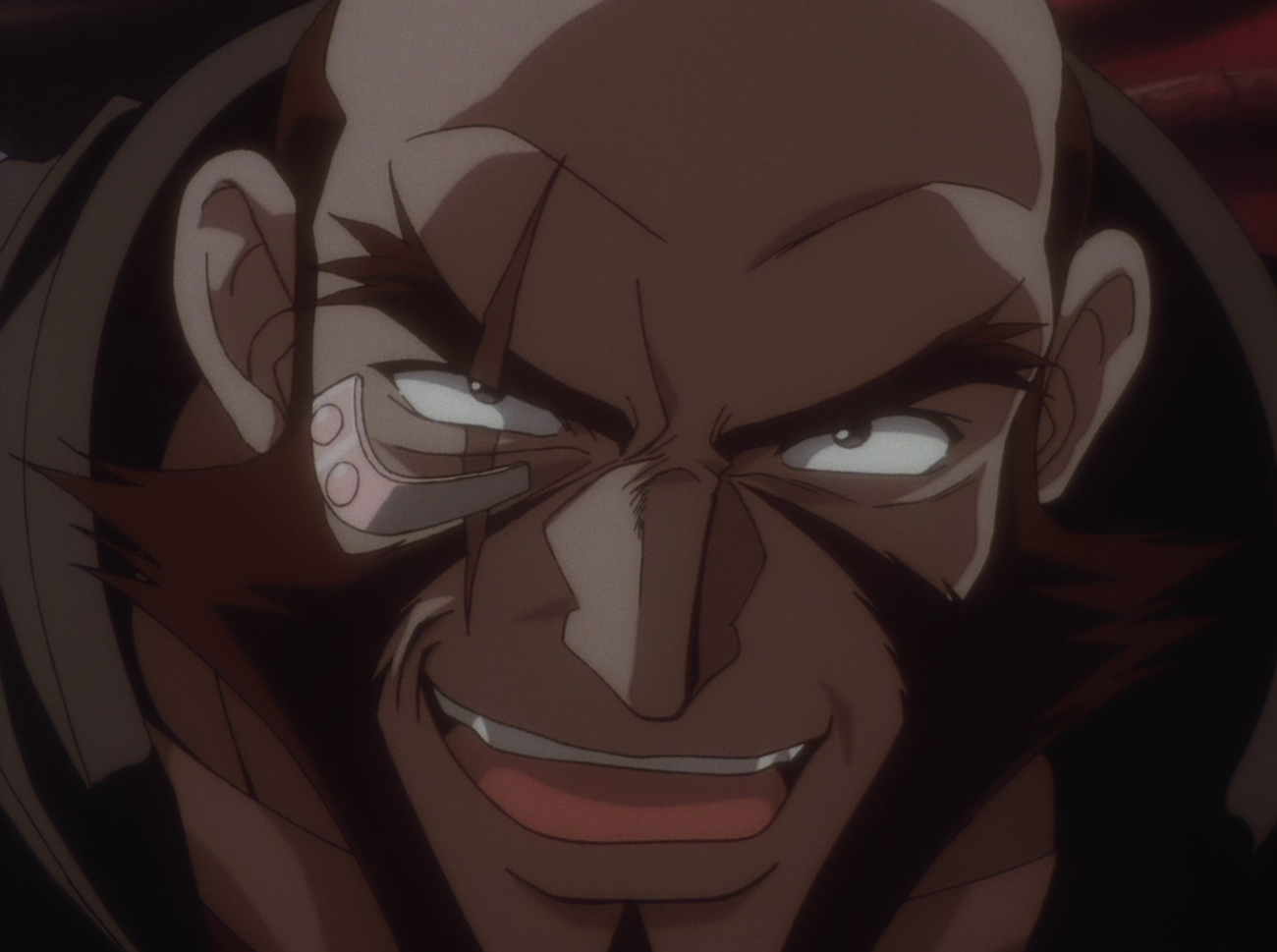
Cowboy Bebop 20th Anniversary Roundtable: Masahiko Minami x Shinichiro Watanabe x Keiko Nobumoto [Japan Expo 2018]
Earlier this month a very special panel was held in France: Japan Expo gathered the main crew behind Cowboy Bebop to talk about the show’s origins and secrets behind its production that they’ve only felt comfortable discussing many years later. Enjoy this very informative but also outright hilarious transcript!
Masahiko Minami: Producer, current head of studio BONES
x
Shinichiro Watanabe: Series directorSeries Director: (監督, kantoku): The person in charge of the entire production, both as a creative decision-maker and final supervisor. They outrank the rest of the staff and ultimately have the last word. Series with different levels of directors do exist however – Chief Director, Assistant Director, Series Episode Director, all sorts of non-standard roles. The hierarchy in those instances is a case by case scenario.
x
Keiko Nobumoto: Series composer
MC presents the series and the tremendous success it had overseas as well as its lasting popularity 20 years on.
Can take us back to the origins of the project?
Minami: At the time I was a producer at Sunrise, the studio responsible for the Gundam series among others. We had a long-lasting partnership with toy-maker Bandai to produce titles meant to promote their merchandise. Although Gundam was very big, Bandai wanted a breath of fresh air and new plastic models to sell. And so they asked us to produce a show that featured spaceships. That’s when I picked up my phone and asked Watanabe: “So when are you getting back to work?“
Watanabe: Keiko, did you know that the project’s one and only purpose was to promote toys? Because when I contacted you for the series compositionSeries Composition (シリーズ構成, Series Kousei): A key role given to the main writer of the series. They meet with the director (who technically still outranks them) and sometimes producers during preproduction to draft the concept of the series, come up with major events and decide to how pace it all. Not to be confused with individual scriptwriters (脚本, Kyakuhon) who generally have very little room for expression and only develop existing drafts – though of course, series composers do write scripts themselves. position, I deliberately omitted that detail. The directive we got from Bandai was for the series to have spaceships and no guidelines regarding the narrative, so I wanted you to focus completely on your ideas. Which is to say, our actual goal was to create a great series the way we saw fit without much concern about Bandai’s request. Once we got back to them with our project draft, they went “what about our toys?!” and backed out. Thankfully, Bandai Visual, their video production and distribution subsidiary, stepped in and saved the day.
Minami: But trouble continued after that! *laughs*
No TV station would accept to broadcast the series based on the first episode because of all the “drugs, violence, and sex.” I tried to convince them that those were not drugs, but rather a power-boosting substance like the one used to increase power and speed in Cyborg 009.
So you had to go through a lot of trouble! But let us go back to the series’ origins. As we can see on the picture on-screen, the series’ name changed somewhat late into the production process from “Swing the Bebop” to the name we know all, “Cowboy Bebop”. Can you talk us through the naming process?
Watanabe: The very first name we had for the series was “Nagareboshi Bebop” (Flying Star Bebop). Due to trademarking issues we had to give up the “Nagareboshi” part but decided to keep the “Bebop“.
Minami: At that moment, I suggested “Beboppo” and “Viva Viva Bepop“.
*everyone laughs*
Watanabe: But then, “Swing the Bebop” came to mind given how the Bebop is a powerful spacecraft that can be swung at will. We had settled for this name for some time until Keiko came up with “Cowboy Bebop” out of nowhere. It felt kinda awkward to all of us so I asked her if she really wanted to go with that name, just to double-check whether she really meant it.
Nobumoto: Since the series stars bounty hunters with the Milky Way as their playing ground, “Cowboy Bebop” sounded really good to me, so I exploited my influence and made sure it went through.
Watanabe: In retrospect, I’m glad we kept it. And now that it’s been 20 years, nothing can be done about it anyway.
Minami: Yeah. I sure am glad we didn’t go with “Viva Viva Bebop.” *laughs*
So many revelations about the series’ origins! How did you all come to work together on the project then?
Watanabe: I’d worked with many of these people on Macross Plus so I just called them over to work on Cowboy Bebop when the offer came. Except for Shoji Kawamori, whom I didn’t invite but still showed up.
Now we know how the project was approved by the sponsors, how you settled on a name and gathered the staff, so let’s move onto the story. Who came up with the original concept and how did it progress from that to the story we saw unfold on-screen?
Watanabe: When we finally sorted out all those elements, I kinda took a break in order to focus completely on the project and went on a trip to an onsen. For work purposes obviously! *laughs*
Minami: The best projects are created while taking a bath!
*everyone laughs*
Watanabe: I had an episodic series in mind from the get-go. I wanted every episode to feel fresh. And all the aforementioned problems we encountered only reinforced that vision of the series I had. Every episode was written like it was the last because we knew the series may be called off any time. But we still needed a thread, albeit thin, common to all episodes for the setting, world elements, characters, etc. So I would sit with Keiko for long, long periods of time. I know that sounds like a lot of work, but only 10% of that time was used to actually brainstorm about the series. The remaining 90% were spent talking about whatever. *Nobumoto laughs*
So in order to have every episode feel different, we enlisted different staff members for every episode. That’s how you end up with episodes written by someone like Dai Sato who had no experience penning a script before that. And it’s also how you end up with episodes where even a producer can contribute to the script, as Minami here present can attest. Remember?
Minami: Yeah. I thought about having enka elements in episode 10 because I felt they would be right at home. So I pitched the idea to the director… and he was not fond of it, to be honest. But he still told me to go through with it and to show him what I could do. And thus I took him at his word and did just that! Right?
Watanabe: *looks the other way* So yeah, my point is…
*everyone laughs*
Watanabe: My point is that we did what we wanted to do with Cowboy Bebop. It was a hard-fought battle but the success of the series proved us right.
Let’s now talk about the cast. What do you think made them so endearing and popular among fans?
Watanabe: We put a lot of work into the cast. I had the character of Spike in mind long before this project, so once I had to come up with the Bebop’s crew, I thought it was finally time to bring that concept to life. That’s when I sat down with Keiko in order to develop him as a person. And to answer your question, I think all the work we put into characters was apparent and people were attracted to that. We wanted the cast to feel real and not just a character with a predefined, set-in-stone personality, either always joyous or mad or whatever, who reacts to events according to a checklist. We wanted them to have human reactions, those you and I could have, to different events.
Minami: They do feel human, even more so thanks to the amazing voice acting. For example, you can see how Spike evolved as a person between episode 1 and episode 20, and his reaction to the same events changed.
Watanabe: Now having different staff members take care of different episodes is cool and all, but it can all quickly get out of hand and have characters feel like they belong to entirely different works. That is why Keiko and I made sure to keep everything in line.
Nobumoto: Yes. For example, in some episodes, there were some lines written for Spike that felt like there was no way he’d ever say no matter the circumstances.
What about the character designs? Did they change a lot over the course of the pre-production period?
All: *they look at the above picture* Eh? Where is this from?!
Watanabe: But honestly, not really. [Toshihiro] Kawamoto grasped the gist of the characters from the few things I told him about them and the brief guidelines he was given, which is honestly impressive considering how green he was as a character designer. The first sketches he sent my way already had everything I had asked for and then some, it satisfied me plenty. The thing is, Kawamoto sort of lacks self-esteem and gets all worked up when his first attempt gets greenlit, thinking that quick approval instead means he’s been deemed hopeless. And so I asked him to come up with alternative designs just to keep him busy and mentally onboard, because we needed him to be in top form during the entirety of the show’s production.
Kawamoto came up with 4 other designs for each character that departed from the first ones in different ways in order to give me a broader perspective. But at the end, we ended up going with the very first ones… though we did make an exception for Ed, simply because the character was first thought as a boy and later became a girl. So I just called him one night and told him to change Ed to a girl and to take a young Yoko Kanno as a model to design her because she’s as much of a genius as the character. The sketch you see in the upper-right corner of that picture is Ed as a boy, and the one below is the female Ed you know.
And speaking of Ed, the cast had 5 characters at first. The fifth one was a kind of cat, but we ended up merging it with Ed – I think it shows in her cat-like traits.
Nobumoto: I thought 5 characters for the main cast was too many.
Watanabe: Once the cat was no more, we decided to bring in a dog.
Watanabe: Keiko wanted a Welsh Corgi so much that Kawamoto even borrowed one from a friend of his to better observe and depict his movement. At first I wanted him to be a dog with a super-computer as a brain, but as we went along I completely forgot about that and only remember it during… episode 23. *laughs*
Thank you very much for all your answers. We will now take some questions from the audience.
- To Mr. Watanabe: as you said Cowboy Bebop is an episodic series, but that applies to many of your series, like Space Dandy for one. Is that due to your love for Lupin III and the influence you took from it as you said in an interview?
Watanabe: Did I say that about Lupin III? I don’t remember. I mean, if you read it somewhere I guess I did. But yeah, I do love Lupin III and it definitely influenced me. It’s the older series that I’m a fan of though, back when he wore a green jacket. *winks through sunglasses*
- Mr. Watanabe, you talked earlier about how many of Cowboy Bebop’s staff were new to the industry at the time. That’s always the case with your series. We discovered many newbies on Space Dandy who used the series as a canvas to express their talent and make a name for themselves in the industry. And for your new project, Carol & Tuesday, you’re holding open auditions for young people from all over the world whatever their background to participate in the music of the series. What is it that makes you always want to work with new, young, inexperienced people?
Watanabe: Everyone has to start somewhere, right? The fact that I directed all these shows that have sometimes turned out to be successful is because I was granted these opportunities in the first place. Young and inexperienced people look at things in way veterans can’t, so they always bring novelty to the table. As for the “new” part, that’s because I think that if you always work with the same group of people, you’ll eventually go full circle and use ideas you have already used, just in different contexts. In my opinion, working with new people can only elevate the work by adding different perspectives. That is why in Cowboy Bebop for instance, everyone contributed to everything: writers to design decisions, designers and producers to scripts, etc. And that is also why for Carol & Tuesday I’m working with 4 French designers – I’m quite happy with their work!
- Cowboy Bebop and Space Dandy have many things in common: both series take place in space, both are episodic with dramatic and comical episodes, and Dandy looks a lot like Spike to boot. And to top it off, Space Dandy was announced in the year Cowboy Bebop celebrated its 15th anniversary. Was Space Dandy kind of an homage to Cowboy Bebop?
Watanabe: I guess the time has come to let you all know the truth. *looks at Nobumoto and Minami* This will blow your minds: Space Dandy is in fact a Cowboy Bebop spin-off! *everyone laughs*
Minami: Eeeeh?! You should have told me that sooner! I would have gotten much more money from sponsors if I pitched it to them as a Bebop spin-off, especially those American Cartoon Network guys. But I’m happy with how I still managed to fool them and get that much money from them. Let’s keep that a secret, though!
Support us on Patreon to help us reach our new goal to sustain the animation archive at Sakugabooru, SakugaSakuga (作画): Technically drawing pictures but more specifically animation. Western fans have long since appropriated the word to refer to instances of particularly good animation, in the same way that a subset of Japanese fans do. Pretty integral to our sites' brand. Video on Youtube, as well as this SakugaSakuga (作画): Technically drawing pictures but more specifically animation. Western fans have long since appropriated the word to refer to instances of particularly good animation, in the same way that a subset of Japanese fans do. Pretty integral to our sites' brand. Blog. Thanks to everyone who’s helped out so far!



This interview was awesome
It would have been very fun to follow the interview in real time. I’m already laughing.
Where was he reaching out to an international pool to recruit for music production? First I’ve heard here.
Perhaps it didn’t make the round enough, but: https://twitter.com/liborek3/status/990872278455017472